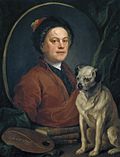File:Drawing (BM 1960,0409.113).jpg

Original file (1,683 × 2,500 pixels, file size: 633 KB, MIME type: image/jpeg)
Captions
Captions
Summary
[edit]| A nude woman by a pyramid; seated, inclining to left, on drapery
( |
||||||||||||||||||||||||
|---|---|---|---|---|---|---|---|---|---|---|---|---|---|---|---|---|---|---|---|---|---|---|---|---|
| Artist |
artist QS:P170,Q171344 |
|||||||||||||||||||||||
| Title |
A nude woman by a pyramid; seated, inclining to left, on drapery |
|||||||||||||||||||||||
| Description |
English: A nude woman by a pyramid; seated, inclining to left, on drapery, a fold of which she holds in her right hand, her head in profile to left, her legs crossed, her left hand upraised and pointing to the pyramid behind her, right, after 1720
Black chalk, heightened with white, on grey paper |
|||||||||||||||||||||||
| Date | 1720-1725 (?) | |||||||||||||||||||||||
| Medium | paper | |||||||||||||||||||||||
| Dimensions |
|
|||||||||||||||||||||||
| Collection |
institution QS:P195,Q6373 |
|||||||||||||||||||||||
| Current location |
Prints and Drawings |
|||||||||||||||||||||||
| Accession number |
1960,0409.113 |
|||||||||||||||||||||||
| Notes |
Stainton & White 1987 This drawing was attributed to Hogarth when it was acquired by the British Museum, and there seems no reason to doubt the attribution. Like other comparable examples noted in A. P. Oppé, 'The Drawings of William Hogarth', London, 1948, nos 25 and 28, this life study was very probably drawn during Hogarth's membership of the academy founded by John Vanderbank and Louis Chéron in St Martin's Lane - Hogarth being one of the initial subscribers in October 1720 - and is among his earliest surviving drawings. The cross-hatched shading shows the influence of Chéron (see 1953,1021.11(86) and 1953,1021.11(71)), although Hogarth's drawing is softer in execution. Hogarth later recalled that at the academy he had begun "copying in the usual way and had learnt by practice to do it with tolerable exactness", until "it ocur'd to me that there were many disadvantages attended going on so well continually copying Prints and Pictures . . . nay in even drawing after the life itself at academys ... it is possible to know no more of the original when the drawing is finish'd than before it was begun". As he observed, in his opinion the best artist was one whose visual memory was so highly developed that he could reproduce complicated forms at will, without the original in front of him, and thus concentrate on his proper business, that of invention: "Whoever can conceive part [of] a Human [figure] with all its circumstances variation[s] when absent as distinct as he doth the 24 letters with their combination[s] is perhaps a greater painter sculptor than ever yet existed" (M. Kitson, 'Hogarth's 'Apology for Painters, 'Walpole Society', xli (1966-8), p. 106). Nevertheless, his early training in drawing from the life was to be valuable to him and he seems never to have entirely abandoned the practice. ......................................................... It is possible that this drawing was in "A parcel of academy figures and studies, by Mr Hogarth and others", Lot 25 in Mrs Hogarth's sale, sold for £11.6s. |
|||||||||||||||||||||||
| Source/Photographer | https://www.britishmuseum.org/collection/object/P_1960-0409-113 | |||||||||||||||||||||||
| Permission (Reusing this file) |
© The Trustees of the British Museum, released as CC BY-NC-SA 4.0 | |||||||||||||||||||||||
Licensing
[edit]This image is in the public domain because it is a mere mechanical scan or photocopy of a public domain original, or – from the available evidence – is so similar to such a scan or photocopy that no copyright protection can be expected to arise. The original itself is in the public domain for the following reason:
This tag is designed for use where there may be a need to assert that any enhancements (eg brightness, contrast, colour-matching, sharpening) are in themselves insufficiently creative to generate a new copyright. It can be used where it is unknown whether any enhancements have been made, as well as when the enhancements are clear but insufficient. For known raw unenhanced scans you can use an appropriate {{PD-old}} tag instead. For usage, see Commons:When to use the PD-scan tag. | |||||
File history
Click on a date/time to view the file as it appeared at that time.
| Date/Time | Thumbnail | Dimensions | User | Comment | |
|---|---|---|---|---|---|
| current | 07:56, 15 April 2023 |  | 1,683 × 2,500 (633 KB) | WideAngleEyes (talk | contribs) | Higher resolution version of the same file from the same source with the same colors |
| 22:40, 10 May 2020 |  | 1,077 × 1,600 (266 KB) | Copyfraud (talk | contribs) | British Museum public domain uploads (Copyfraud/BM) Prints by William Hogarth in the British Museum 1720 #72/1,429 |
You cannot overwrite this file.
File usage on Commons
The following 2 pages use this file:
Metadata
This file contains additional information such as Exif metadata which may have been added by the digital camera, scanner, or software program used to create or digitize it. If the file has been modified from its original state, some details such as the timestamp may not fully reflect those of the original file. The timestamp is only as accurate as the clock in the camera, and it may be completely wrong.
| Date and time of digitizing | 14:51, 3 May 2007 |
|---|---|
| File change date and time | 14:51, 3 May 2007 |
| Date metadata was last modified | 14:51, 3 May 2007 |
| Software used | Adobe Photoshop Elements 3.0 Windows |


